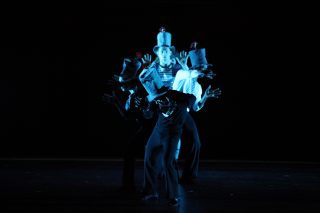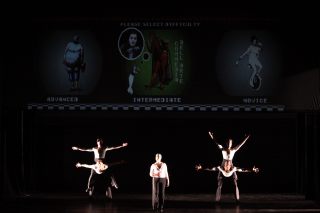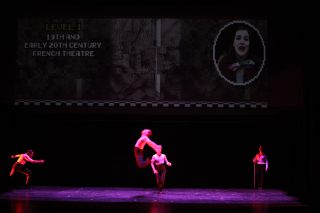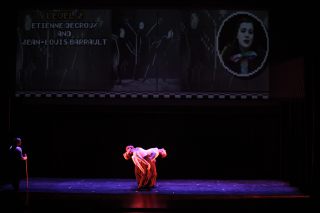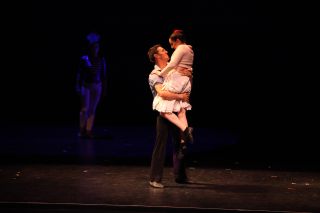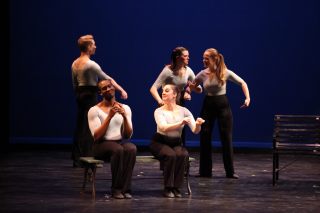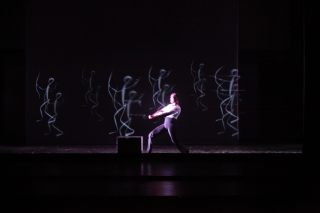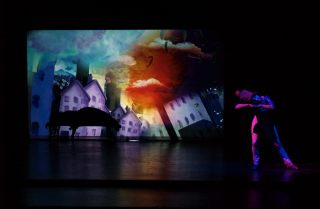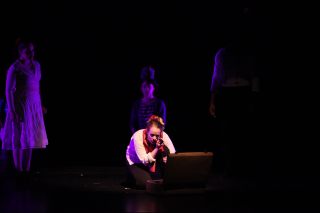| Theatre | |||||||||||||||||||||||||||||||||||||||||||||||||||
| New Works Creation | |||||||||||||||||||||||||||||||||||||||||||||||||||
| There Is No Silence | Conceiver, Director & Choreographer |  |
|||||||||||||||||||||||||||||||||||||||||||||||||
|
|||||||||||||||||||||||||||||||||||||||||||||||||||
| Venue and Dates: | |||||||||||||||||||||||||||||||||||||||||||||||||||
|
|||||||||||||||||||||||||||||||||||||||||||||||||||
| About: | |||||||||||||||||||||||||||||||||||||||||||||||||||
|
There Is No Silence is a two-hour interdisciplinary multimedia play about the life and work of the great French mime artist, Marcel Marceau. It was collaboratively created through a year and half-long devising process by faculty, MFA actors and production design team. It was performed by the MFA actors. The storyline includes four actors portraying Marcel Marceau at different stages of his life, Marceau’s performance persona Bip, Marceau’s wife Anne Sicco, his daughter Aurelia, and a hobo mime who narrates the show. The innovative technology used was integrated throughout the production. It included a projection system that wrangled live performance animation, prerecorded 3-dementional animation, video and live silhouette shadow performance. The physical setup on the stage was comprised of six movable projection surfaces, a motion capture area integrated into the main performance space, lighting with traditional and LED lights that facilitated live silhouette integration and animation projections, and full proscenium sized automated curtains that allowed for dynamic framing of live and projected action. We came to consider this work a type of augmented reality: real, live events, being augmented, changed, with virtual environments responding in real time. This work exquisitely demonstrates breadth and integrity of research conducted by faculty, staff and students through the creation of new work, collaboration and partnership. The time intensive development process included many branches of investigation. While learning mime technique, the students learned Marcel Marceau’s adagio “At The Bar” by watching ACCAD’s motion capture of him doing it. The students were then motion captured doing the adagio. This culminated by the students analyzing the distinctions in the nuances of gesture and timing by comparing and contrasting their motion capture alongside Marceau’s motion capture. As well, the multiple ways that the technology was used in the production were developed along with the script and choreography. This enabled the technology to be integrated throughout the entire production, instead of, which often happens, the technology being layered on top of the work after it is developed. Also, to develop the script and choreography, materials were utilized from the Marcel Marceau Archive, hosted in the OSU Theatre Research Institute (TRI) and the University of Wyoming American Heritage Museum’s Bertha Klausner Archive of Marcel Marceau. Resource material of Marcel Marceau that was re-envisioned and transformed include: of his choreography, The Cage, The Creation of The World, The Public Garden, and the water adagio; his motion capture; his paintings and his book The Story of Bip. And finally, perhaps one of the most moving sections of the play was the realization of Thompson’s first idea for the production: a “live” duet with one of the MFA actors and Marcel Marceau. This was achieved by projecting Marceau’s previously recorded motion capture side-by-side with the student’s live motion capture – thus allowing them to exist, seemingly spontaneously in space and time, together at the bar. Coinciding with the production were an Exhibit of Marcel Marceau’s Memorabilia with historical programs, lithographs of his paintings, documentation of his residencies at OSU and his motion capture suit, and a symposium titled Making the Invisible Visible: Mime’s Contemporary Legacy, with numerous internationally known mime and movement theatre artists. Grant support that Thompson received included OSU Arts and Sciences Research Enhancement, Coca-Cola Critical Difference for Women, Arts & Humanities Associate Professor Mentoring Program, and the Bertha Klausner Fellowship Award. This research was shared by Thompson, Berezina-Blackburn and Oliszewski at the following 2015 conferences: International Federation for Theatre Research Bodies on Stage: Acting Confronted by Technology, Paris, France, Association for Theatre in Higher Education Je me souviens / I remember, Montreal, Canada, United States Institute for Theatre Technology, Cincinnati, Ohio, and ACCAD’s Open House, Columbus, Ohio. |
|||||||||||||||||||||||||||||||||||||||||||||||||||
| Reviews: | |||||||||||||||||||||||||||||||||||||||||||||||||||
|
“Those who revel in “the poetry of the gesture” are in for a treat. “There Is No Silence: A Fantasia Inspired by the Great French Mime Artist Marcel Marceau,” conceived and directed by the master’s disciple and longtime OSU faculty member Jeanine Thompson, serves as a gift both to his memory and to the audience... Considering the taciturnity of Marceau’s art, the OSU production accurately exemplifies its title, giving voice to each of its eight Master of Fine Arts acting candidates; included are personal anecdotes from all of the candidates, Marceau’s biography, his place in the history of the moving arts, his philosophy and teaching... Thanks to motion-capture done during the third of Marceau’s OSU residencies in 2001, the Advanced Computing Center for the Arts and Design enables (Patrick Wiabel) to perform an interactive duet with the late mime and for others of the cast to project into his illustrations.” -- Jay Weitz COLUMBUS ALIVE |
|||||||||||||||||||||||||||||||||||||||||||||||||||
|
“Sarah Ware excels as a delicately captivating version of Marceau’s Chaplinesque creation, Bip, who silently observes and responds to much of the action.” -- Margaret Quamme COLUMBUS DISPATCH |
|||||||||||||||||||||||||||||||||||||||||||||||||||
Media: |
|||||||||||||||||||||||||||||||||||||||||||||||||||
|
|||||||||||||||||||||||||||||||||||||||||||||||||||










